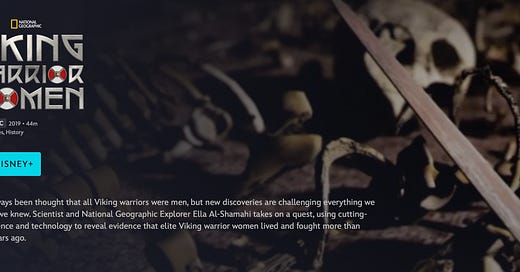From Birka to Disney+: The Rise of the Viking Warrior Woman
A historian reviews the Disney+ documentary and cautions what the evidence actually says.
I finally got around to watching Viking Warrior Women, the 2019 National Geographic documentary now streaming on Disney+. The film, hosted by Ella Al-Shamahi, explores the increasingly compelling evidence that some women in Viking Age Scandinavia took on martial roles.
It centers on the now-famous Birka warrior grave in Sweden. It also investigates similar high-status female burials in Denmark and Norway—each containing weapons and clues that challenge our assumptions about gender roles in the Viking world.
A Strong Start
Al-Shamahi is an engaging and charismatic presenter, and the film is visually stunning. It moves at an appropriate pace while highlighting some of the most exciting discoveries in Viking archaeology in recent years.
I especially appreciated the segment with Leszek Gardeła—a friend of the Vikingology Podcast—who analyzes the axe found in the Danish grave. He confirms it's a war axe, not a domestic tool, which is a significant distinction. The implication that this woman was at least partially engaged in martial activity is fascinating and worth further investigation.
Where It Stumbles
While Viking Warrior Women succeeds in drawing attention to overlooked stories in the archaeological record, it does suffer from a persistent flaw: a tendency to jump to conclusions that aren't fully supported by the evidence.
Al-Shamahi, while passionate, seems too eager to confirm her preexisting beliefs. She repeatedly states what she “believes” to be confirmed before presenting the data and then frames the evidence to support those beliefs—often ignoring more nuanced or cautious interpretations. She even says at one point, “I choose to believe,” in offering her conclusions about the grave site in Norway.
As a further, more emblematic example, the documentary ends with a facial reconstruction of the Birka warrior woman, whose skull bears a healed cranial injury. This moment is framed as a triumphant “proof” that she saw battle. The so-called “battle wound” on the Birka skull is treated uncritically as proof of combat experience, despite the fact that such an injury could just as plausibly have resulted from domestic violence or an accident.
Similarly, the sequence at Repton with Dr. Cat Jarman implies that female remains in a military burial automatically equates to female warriors. Yet Jarman’s own book clarifies that many women likely accompanied the Great Heathen Army as part of family groups and that Viking armies often traveled with entire households.
The documentary misses a valuable opportunity to clarify the distinction between the evidence and the presenters' beliefs, which adds to a growing tendency to treat possibility as proof.
The Takeaway
All said, the broader implications of the archaeological findings are thought-provoking. For instance, the osteological analysis of the Birka skeleton revealed that spinal and shoulder wear is consistent with a life of archery. That kind of evidence is hard to ignore.
Taken together with weapon burials, grave prominence, and new typologies of martial objects, we're beginning to see a clearer picture: at least a few women in the Viking Age appear to have taken on roles traditionally associated with men.
This doesn’t mean Viking society was egalitarian or that shieldmaidens were the norm. But it does mean that the social roles available to women may have been more flexible than previously thought—and that’s incredibly exciting.
Final Thoughts
In the end, Viking Warrior Women is a compelling watch. Despite its flaws, it shines a spotlight on an important and evolving field of study. Just don’t take all its conclusions at face value. It is, after all, entertainment.





